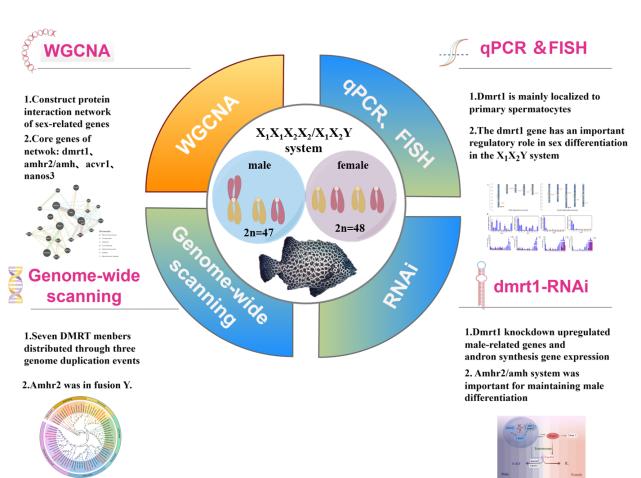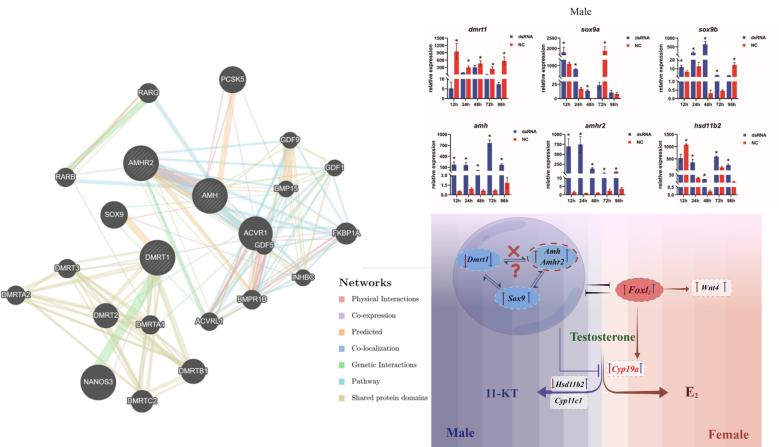Recently, the research team led by Prof. LI Jun from the Institute of Oceanology of the Chinese Academy of Sciences (IOCAS) revealed the regulation mechanism of sex differentiation in the important cultured fish, spotted knifejaw (X1X1X2X2/X1X2Y).
The study was published in International Journal of Biological Macromolecules on Dec. 7.
Previous studies have found that the DMRT (Doublesex mab-3 related transcription) family plays an important role in male sex determination and differentiation, but its regulatory role in Oplegnathus punctatus, with a Y-fusion chromosome, remains unclear. "To tackle the remaining challenge of understanding the determination and differentiation mechanisms of fish in the X1X2Y system, we carried out a comprehensive study on the regulation mechanism of sex differentiation in spotted knifejaw," said ZHAO Haixia, first author of the study. "This involved integrating female-male whole-genome variation scanning, transcriptome sequencing of the gonads, WGCNA (Weighted correlation network analysis) of gonadal developmental time series, identification and analysis of gene family members, and biological verification experiments such as FISH (Fluorescence in situ hybridization) in gonadal cells and RNAi (RNA interference)."
The study established a database of transcriptome differences in the male and female gonads during the developmental time series of spotted knifejaw. Based on WGCNA analysis, a regulatory network of differentially expressed genes in the X1X1X2X2/X1X2Y complex chromosomal system was constructed, revealing core genes involved in the regulation of male gonadal development in spotted knifejaw, such as dmrt1, amhr2/amh, acvr1, and nanos3. Based on whole-genome scanning analysis, seven members of the dmrt gene family were identified in spotted knifejaw, namely dmrt1/2 (2a, 2b)/6, dmrt4/5, and dmrt3.
Researchers proposed, for the first time, that spotted knifejaw underwent three genome duplication events based on the chromosomal distribution pattern of dmrt genes. The whole-genome scanning results showed that the sex-related gene amhr2 was located on the fused chromosome (Y). Transcriptome analysis during gonadal development, as well as qPCR and FISH results, confirmed the important regulatory role of the dmrt1 gene in the sex differentiation of male and female gonads in spotted knifejaw with the X1X2Y system. Further studies using dmrt1 dsRNAi demonstrated that knocking down dmrt1 did not downregulate the male-related genes, but instead significantly upregulated genes closely associated with male differentiation (such as sox9a, sox9b, amh, amhr2) and the key gene involved in testosterone synthesis (hsd11b2).
Additionally, the existence of another main pathway driving male differentiation and maintaining testosterone synthesis in spotted knifejaw with the X1X2Y system, in addition to dmrt1, which is closely related to male differentiation. It is worth noting that knocking down dmrt1 resulted in the persistent and efficient expression of the amhr2/amh system located on the male heteromorphic chromosome Y, and even promoted the expression of the testosterone synthesis gene hsd11b2. This suggests that amhr2 may play an irreplaceable role in the gender differentiation process of spotted knifejaw.
"The study revealed for the first time the origin and evolution pattern of the DMRT gene family in the Oplegnathidae fish," said Dr. XIAO Yongshuang, corresponding author. "Based on RNAi technology, it systematically elucidated the role of the dmrt1 gene in the sex differentiation process of spotted knifejaw, and constructed a regulatory network of sex differentiation in fish with the X1X2Y system mediated by dmrt1."
"The research results enhance our understanding of the regulation of sex differentiation in fish with the fusion chromosome system (X1X1X2X2/X1X2Y), and lay an important foundation for further elucidating the sex determination and sex differentiation mechanisms of fish with fused chromosomes (Y) in the X1X2Y system," added Prof. LI.
This work was supported by the National Key Research and Development Program, National Natural Science Foundation of China; Key Deployment Projects of Center for Ocean Mega-Science, Chinese Academy of Sciences, and CARs for Marine Fish Culture Industry.

Fig. 1 Study design for the regulation of sex differentiation in Oplegnathus punctatus.

Fig. 2 Interactions among differentially expressed genes in the gonads and the regulatory network governing sex differentiation in spotted knifejaw.
Haixia Zhao, Yongshuang Xiao*, Zhizhong Xiao, Yanduo Wu, Yuting Ma, Jun Li*, Angel Herrera-Ulloa. (2023). Genome-wide investigation of the dmrt gene family sheds new insight into the regulation of sex differentiation in spotted knifejaw (Oplegnathus punctatus) with fusion chromosomes (Y). International Journal of Biological Macromolecules. DOI: 10.1016/j.ijbiomac.2023.128638.
(Text by XIAO Yongshuang)
Media Contact:
ZHANG Yiyi
Institute of Oceanology
E-mail: zhangyiyi@qdio.ac.cn
(Editor: ZHANG Yiyi)

